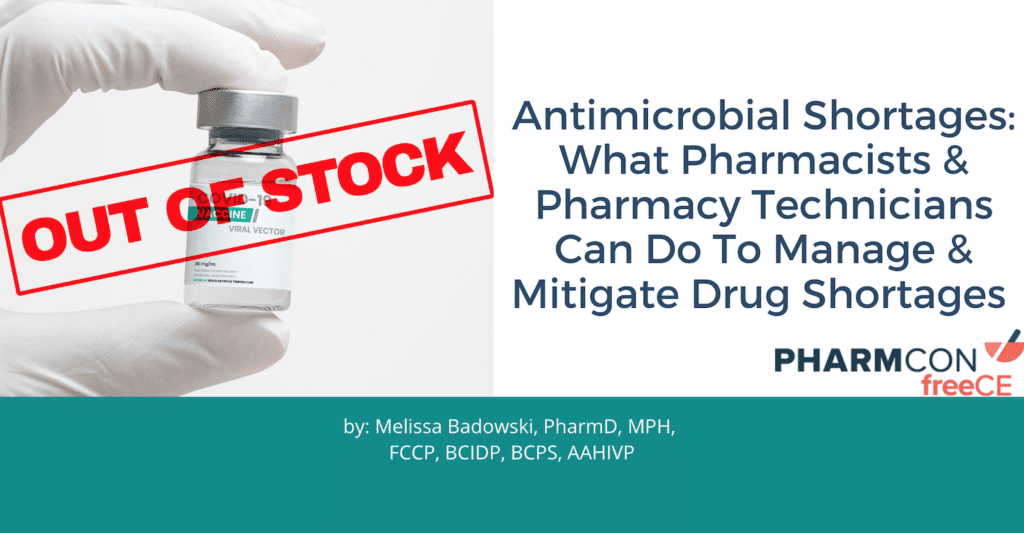Drug shortages remain a persistent concern in the United States. The annual labor cost of managing a drug shortage in the healthcare setting is approximately $360 million which accounts for 8.6 million hours of additional labor.1 What is the reason behind all of these recent drug shortages?
Drug shortages can happen due to various factors including problems with manufacturing and quality, discontinuation of products, economic factors, inadequate supply chain visibility, delays in production, unanticipated increase in demand, raw material shortage, and relying on foreign and specific geographic locations for the production of medications.2
These shortages can lead to detrimental effects on clinical outcomes for patients such as delays in care, suboptimal treatment, adverse effects, and medication errors. From a cost perspective, patients may incur greater out-of-pocket costs and insurance premiums while health system costs may increase due to management or mitigation strategies such as medication waste and limited staff to manage such shortages.
Drug Shortages & Infectious Diseases
Drug shortages remain a pressing issue especially in the area of infectious diseases. As of recent, the uptick in antibiotic shortages has been due to the unanticipated increase in demand for these products. Even with the end of the public health emergency, drug shortages still threaten public health.
By the end of 2022, an all-time five year high of 295 active drug shortages were present accounting for a 30% increase between 2021 and 2022 alone.3 Currently, 47 new drugs were introduced to the list of drug shortages in 2023 where injectable and non-injectable antimicrobials remain one of the top 5 drug classes experiencing shortage.4 Even more concerning is that the average length of a drug shortage is approximately 1.5 years. In the case of ampicillin-sulbactam, cefotaxime injection, ceftazidime, clindamycin injection, and vancomycin injection, these antimicrobial agents have remained in shortage for over a decade.3
Yet, commonly prescribed antibiotics such as amoxicillin and long-acting penicillin G intramuscular injection are exceeding the currently available supply due to increased demand. For instance, some of the uses of these antibiotic agents have been met with increased cases of bacterial infections secondary to viral infections. These secondary infections during the COVID-19 pandemic were likely reduced due to expanded efforts to mitigate their transmission such as mask use and increased hand hygiene.
The shortage of long-acting penicillin G intramuscular injection is expected to continue into 2024. Pfizer, the sole manufacturer responsible for production of penicillin G benzathine, anticipates exhausting its supply of this formulation for children in the near future. It is recommended that priority for women who are pregnant should be granted while this product remains in short supply. But Pfizer does not expect the adult formulation of the intramuscular injection to be completely depleted.5
OTC Drug Shortages
These drug shortages do not stop with prescription drugs. Recently, over-the-counter products such as children’s acetaminophen and ibuprofen were difficult to come by due to surges in viral respiratory infections.2 With each passing day, the threat of another drug shortage looms. It is imperative for pharmacists and pharmacy technicians to be prepared to handle a drug shortage.
Steps to manage and mitigate a drug shortage
- Determine how much supply is on hand within your setting
- Maintain inventory and a list of medications in short supply
- Monitor FDA site for active drug shortages which is updated daily with new or resolved drug shortages
- Develop protocols and contingency plans on ways to mitigate drug shortages should they arise
- Assess length of drug shortage, if known or communicated by the drug manufacturer
- Coordinate with other health systems, when possible, to locate drug in short supply
- Prioritize judicious use of anti-infectives to those in greatest need (i.e. Bicillin-LA in pregnancy) assists in maintaining supply and preventing resistance
- Identify suitable alternatives that take into consideration similar spectrum of activity to the drug in shortage
- Avoid recommending an antimicrobial agent with broad spectrum of activity instead of one with a narrow spectrum of activity
- Utilize compounding pharmacies to obtain antimicrobial in short supply
- Compounded medications are covered under insurance if no alternative therapy is available and deemed medically necessary. Communication with the insurance company and/or prior authorization may be needed prior to obtaining the antimicrobial agent
- Communicate antimicrobial shortages with prescribers
- Prescribers may be unaware of the shortage and continue prescribing antimicrobial treatment causing a delay in initiation of anti-infective therapy
- Ensure all necessary treatment is available and provided for the patient
- For example, if tuberculosis treatment is initiated with rifampin, isoniazid (and pyridoxine), pyrazinamide, and ethambutol, ensure all medications are dispensed/given to the patient at the same time or an alternative is substituted for the antimicrobial in shortage
- Numerous instances have occurred where a drug is in shortage yet a patient thinks they are on the correct therapy only to find out one of the medications is missing (and may have been receiving the wrong medication regimen for weeks or months), thus promoting the potential development of resistance due to suboptimal therapy
Having processes in place prior to the development of a drug shortage are essential in all aspects of pharmaceutical care to reduce any further interruptions in patient care and subsequent negative patient outcomes. It is also important to expand public health efforts to prevent additional increases in infections and their consumption of necessary antimicrobial therapy. Both pharmacists and pharmacy technicians are vital in navigating and mitigating antimicrobial shortages, especially when these shortages can last a year or more.
References
1.) Vizient. New Vizient Survey Finds Drug Shortages Cost Hospitals Just Under $360M Annually in Labor Expenses. Accessed June 20, 2023. https://newsroom.vizientinc.com/en-US/releases/new-vizient-survey-finds-drug-shortages-cost-hospitals-just-under-360m-annually-in-labor-expenses.
2.) Food and Drug Administration (FDA). Drug Shortages. Published June 7, 2023. Accessed June 20, 2023. https://www.fda.gov/drugs/drug-safety-and-availability/drug-shortages.
3.) United States Senate Committee on Homeland Security and Government Affairs. Short Supply: The Health and National Security Risks of Drug Shortages. Published March 22, 2023. Accessed June 20, 2023. https://www.hsgac.senate.gov/wp-content/uploads/Drug-Shortages-HSGAC-Majority-Staff-Report-2023-03-22.pdf
4.) American Society of Health-System Pharmacists (ASHP). Drug Shortages Statistics. Published March 31, 2023. Accessed June 20, 2023. https://www.ashp.org/drug-shortages/shortage-resources/drug-shortages-statistics?loginreturnUrl=SSOCheckOnly
5.) ASHP. Penicillin G Benzathine. Published June 15, 2023. Accessed June 20, 2023. https://www.ashp.org/drug-shortages/current-shortages/drug-shortage-detail.aspx?id=909&loginreturnUrl=SSOCheckOnly






